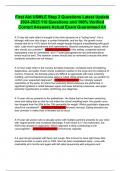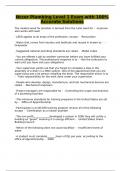First Aid USMLE Step 3 Questions Latest Update
2024-2025 110 Questions and 100% Verified
Correct Answers Actual Exam Guaranteed A+
A 10 day old male infant is brought to the clinic because he is "acting funny". He is
lethargic with poor skin turgor, a sunken fontanelle, and dry lips. His growth curve
reveals that he is <10% below his birth weight despite frequent breastfeeding with good
latch. Labs show hyponatremia and hyperkalemia. Beyond evaluating for sepsis, which
labs should you consider? - CORRECT ANSWER: In this setting, congenital adrenal
hyperplasia must be considered, and 17-hydroxyprogesterone and androstendione
levels must be sent. The newborn screen should also be reviewed to ensure that other
metabolic disorders are not missed.
A 12 hour male infant in the nursery develops fussiness, increased work of breathing,
diaphoresis, and pallor. Exam shows scattered crackles in the lungs and no evidence of
murmur. However, his femoral pulses are difficult to appreciate with lower extremity
mottling, and brachial-femoral pulse delay is noted. What simple test can you perform to
confirm your suspected diagnosis? - CORRECT ANSWER: Your strongly suspect
coarctation of the aorta, for which four extremity blood pressures are performed. A
significant gradient is noted between upper and lower extremity pressures, and upper
extremity hypertension is noted, confirming your diagnosis.
A 15 year old boy presents to the pediatrician. He states that he has been exercising
more and eating less so that he can make the school wrestling team. His growth curve
has dropped from the 50th to the 15th percentile for weight. Which psychiatric diagnosis
should be considered? - CORRECT ANSWER: Anorexia nervosa. Eating disorders are
less common in males than in females but do occur.
A 19 year old woman who is sexually active with multiple partners presents to your clinic
with vaginal pruritis and increased discharge. A wet mount is (+) for protozoans, but
KOH prep reveals no organisms. Which organism is likely contributing to her
vulvovaginitis? - CORRECT ANSWER: Trichomonas vaginalis
A 2 year old girl presents with fever and cough. She is found to have right lower lobe
pneumonia both on exam and on CXR. She has been hospitalized twice - once with
mastoiditis at 6 months and again with left sided pneumonia with empyema and
,bacteremia at 15 months. Her weight is less than the third percentile for age. In addition
to an acute workup, what tests would you consider? - CORRECT ANSWER: A healthy
child is unlikely to have multiple severe infections in different anatomic locations.
Therefore, primary immunodeficiency and other chronic diseases should be considered.
Accordingly, a CBC, immunoglobulin levels, antibody titers to vaccinations, and a CH50
should be ordered. More specific tests (HIV, CF) can be ordered if indicated.
A 20 year old woman is pulled unconscious from a cold lake 5 minutes after her sailboat
capsized. Despite the problems associated with hypothermia, her near drowning is likely
to have a outcome than other causes of hypoxia. Why is this the case? - CORRECT
ANSWER: Activation of the diving reflex (reflex bradycardia and breath holding), which
reduces metabolic demands and the effects of hypoxemia, shunts blood to the vital
organs and limits aspiration of water.
A 20 year old woman with type 1 DM presents with abdominal pain. Labs reveal a
glucose level of 270 mg/dL, HCO3 14, and an anion gap of 20. She is stated on IV fluids
and insulin. Repeat labs show glucose of 190 mg/dL, HCO3 16, anion gap 17. What is
the next step in management? - CORRECT ANSWER: Continue the insulin drip and
add glucose. Insulin drip should be continues until the anion gap closes, not until the
glucose normalizes.
A 20 year old, 154 lbs (70 kg) college student was attempting to light a campfire when
his shirt caught on fire. Because of the remote location, it took EMS 2 hours to bring the
patient to the ED. On exam, you estimate a 30% body surface full thickness burn. What
is the initial fluid administration rate? - CORRECT ANSWER: The rate should be 0.5 x
70 kg x 4 cc/kg x 30% / 6 hours = 700 cc/hour. The Parkland formula requires that half
the volume be given in the first 8 hours (0.5), is weight based (70 kg x 4 cc/kg), and
depends on the surface area burned (30%). Why divide 6 hours and not 8? Because
we're already 2 hours in from the initial burn.
A 22 year old Jehovah's Witness presents with GI bleeding but states that he does not
want a blood transfusion. His hematocrit falls from 40 to 22%, and his BP falls as well.
The patient is urged to accept lifesaving treatment but refuses. When his BP reaches a
critical level, one of his physicians initiates plans to transfuse. What ethical principles
are involved, and which principle trumps the other? - CORRECT ANSWER: This is a
conflict between beneficence and autonomy. The physician aims to bring a good
outcome for the patient (beneficence), but the patient is deciding in accordance with his
belied system (autonomy). The principle of autonomy trumps beneficence in this
situation.
, A 23 year old female heroin user is diagnosed with osteomyelitis. Her history is
significant for sickle cell anemia. While you are awaiting culture results, she needs to
begin empiric antibiotic treatment. In addition to S aureus, for which additional
organisms is this patient at risk? - CORRECT ANSWER: Her IV drug use puts her at
risk for Pseudomonas infection, and her sickle cell anemia puts her at risk for
Salmonella.
A 23 year old woman with a history of irregular menses has been unable to conceive for
2 years. Her partner's infertility workup has been (-). The patient has diabetes,
diagnosed at age 14, but is otherwise healthy. She is 5'2", weighs 165 lbs (74.8 kg), and
has acne. What could you expect to find on exam and imaging? - CORRECT ANSWER:
The patient probably has PCOS. You may find enlarged ovaries on bimanual exam and
many follicles on her ovaries on ultrasound.
A 24 year old man being treated for depression reports that his depressive symptoms
have greatly diminished on fluoxetine 80 mg, but he is now having "intimacy issues",
specifically erectile dysfunction. What are options for treatment? - CORRECT ANSWER:
Rule out medical causes of erectile dysfunction. Reduce the high dose of SSRI, change
to non-SSRI antidepressant, augment with buproprion, or add sildenafil.
A 24 year old medical student develops a rash when he puts on a pair of latex
examination gloves. What is the mechanism leading to this rash? - CORRECT
ANSWER: Allergic contact dermatitis is a result of delayed contact (type IV)
hypersensitivity caused by allergen-primed memory T lymphocytes (vs irritant contact
dermatitis, which results from cytokines released following irritant contact).
A 25 year old man becomes involved in a bar fight and sustains a "fight bite" (closed fist
injury) to his hand. The wound culture grows gram (-) rods. What is the most likely
pathogen, and how should it be treated? - CORRECT ANSWER: Eikenella corrodens,
the most likely pathogen, is common in human bit infections that are sustained in
closed-fist injuries. Treat with amoxicillin/ clavulanate.
A 26 year old IV drug user is admitted to the hospital with fevers and chills. Despite
broad antibiotic therapy, blood cultures remain persistently (+), but TTE is normal. Given
your suspicion of infective endocarditis, what is your next step? - CORRECT ANSWER:
Order a TEE, which is more sensitive than TTE for visualizing vegetations and





